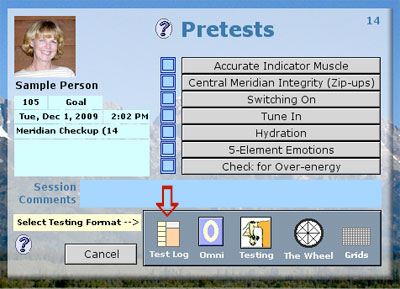

eTouch
for Health...
Tips and Special Features
 |
 |
eTouch
for Health... |
|
| Return to Tips Menu | |||
eTip-016 Adding Opposing Muscles while in an Active Session |
|||
In this eTip, we examine a basic concept of Touch for Health (TFH), the Opposing Muscle Theory, and see how it is implemented in the eTouch software. The benefit will be that you will be able to use one of the basic theories of TFH in a more effective manner. An example used in Touch for Health to illustrate this theory uses a swinging door with a spring on each side. When the door swings to a side, one spring stretches while the other contracts (extension and flexion). When in balance, the door is held in position as illustrated in Fig. 1. However, if one spring becomes weakened or broken, the door will be pulled by the strong spring and will become knotted as shown in Fig. 2.
This eTip demonstrates the process for adding Opposing Muscles. The technique is the same for the other two options.
|
Discovery and Application of the Opposing Muscle Theory Dr. George Goodheart, DC discovered how opposing muscles are involved in our balance. Goodheart made a seemingly common-sense, yet revolutionary observation: Although, we feel pain when muscles are tight or in spasm and the spine is pulled out of alignment, the problem isn't necessarily located in the muscle that hurts. Most of the time, the muscle isn't actually having a spasm. Rather, weak muscles on one side of the body can cause opposing normal muscles to become tight. – John Thie Dr. Sheldon Deal, DC, ND et al, included the theory as one of the basic concepts in Applied Kinesiology (AK), Dr. John Thie, DC included it as one of the basic tenets of Touch for Health (TFH) and Richard Utt included the concept in Applied Physiology (AP). Earl Cook wrote the algorithms and software logic for including this concept in the eTouch for Health software as shown in the is eTip.
When we find a tight or knotted muscle, it is a common practice to work directly on that (strong) muscle itself, kneading and stretching to relax it. However, it may be tight and knotted because it is attempting to do its function and that of its opposing muscle which has been weakened for some reason. In Touch for Health whenever we find an unlocking or weakened muscle, we use our simple and natural balancing techniques to assist the body as it regains its balance while using its innate capabilities. Dr. Thie liked to do a basic 14-muscle balance and then do what he called going outside the circle whenever one of the 14 TFH Indicator Muscles was found to be unlocking. He would then check: any opposing muscles; muscles on the same meridian; or muscles generally associated in function or area of the body. |
||
| Adding Opposing Muscles in an Active Session | |||
|
You will be taken to the New Session screen (shown below).
|
||
New Session Screen
|
The New Session screen, shown below, is the first screen when creating a new session using the Session wizard. Here you select your Focus and Type of session. We selected a Goal balance with a 14 checkbox. It is next to Include: near the bottom of the screen.
|
||
| Pretests Screen | |||
Select Testing Format on Pretests Screen
|
 |
||
| Test Log - Adding Opposing Muscles | |||
| Above is a portion of the Test Log. Record your results here. We found the Quadriceps to be inhibited. (We use weak and OK for space concerns in the Log but the preferred language is inhibited, unlocking or out-of-balance.) You can see that the Quadriceps are highlighted in the Test Log. This indicates that is it the current record. Using the Opposing muscle theory, we decide to also check the opposing muscle for Quadriceps. | |||
|
 |
||
|
The Hamstrings will be added to your session since they are the only opposing muscles for the Quadriceps. As a result, your 14-muscle session is now a 15-muscle session. You can continuing adding muscles in this manner until all 42 muscles have been added. Note: In the figure below, the Hamstrings are highlighted in yellow and there is an "O" located to the left of its name indicating that it was added as an opposing muscle. The Quadriceps are highlighted blue indicating the muscle that the Hamstrings are opposing. The 'S' to the left of Quadriceps simply means this muscle was the starting point for the addition. If a muscle has no opposing muscles not currently in the session, it will read "All Opposing Added".
|
|
|